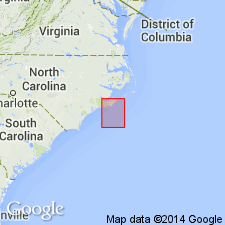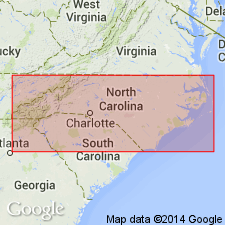
- Usage in publication:
-
- Arapahoe sand member*
- Modifications:
-
- Original reference
- AAPG geologic province:
-
- Atlantic Coast basin
Summary:
Flanner Beach Formation of Du Bar and Solliday (1963) adopted for use by the USGS and stratigraphically restricted to exclude their Minnesott Ridge sand and other younger Pleistocene beds. Includes three informally named members: Beard Creek silty sand member, Arapahoe sand member and correlative Newport sand member. Unconformably overlies Yorktown Formation. Age is Pleistocene (pre-Sangamonian?).
Source: GNU records (USGS DDS-6; Reston GNULEX).

- Usage in publication:
-
- Arapahoe Sand Member
- Modifications:
-
- Principal reference
- Dominant lithology:
-
- Sand
- Mud
- AAPG geologic province:
-
- Atlantic Coast basin
Summary:
Barrier sand deposits exposed near Smith Gut and at the Pine Cliff Recreation area in the Neuse River valley, Pamlico Co., NC, are here named the Arapahoe Sand Member of the Flanner Beach Formation, following the informal usage of Mixon and Pilkey (1976). The Member consists of cross-stratified, fine to coarse sand, sandy mud, and pebbly sand with clay laminations and cylindrical burrows. Gradationally overlies the Smith Gut Member of the Flanner Beach; intertongues to the west with the Beard Creek Member of the Flanner Beach and is truncated to the east by the Suffolk (Grantsboro) Scarp. Thickness is up to 7.5 m. Age is middle Pleistocene.
Source: GNU records (USGS DDS-6; Reston GNULEX).
For more information, please contact Nancy Stamm, Geologic Names Committee Secretary.
Asterisk (*) indicates published by U.S. Geological Survey authors.
"No current usage" (†) implies that a name has been abandoned or has fallen into disuse. Former usage and, if known, replacement name given in parentheses ( ).
Slash (/) indicates name conflicts with nomenclatural guidelines (CSN, 1933; ACSN, 1961, 1970; NACSN, 1983, 2005, 2021). May be explained within brackets ([ ]).

